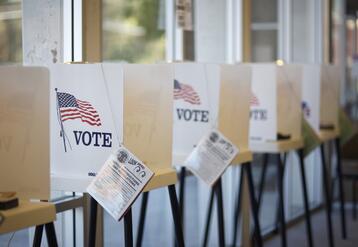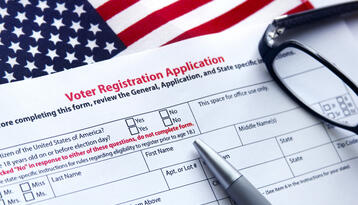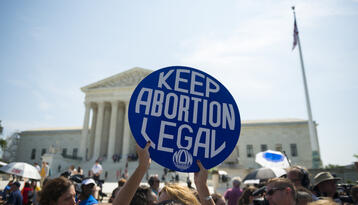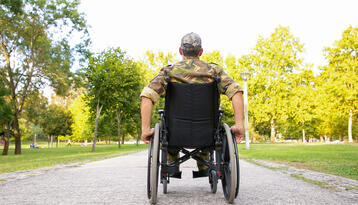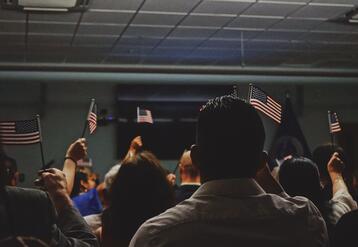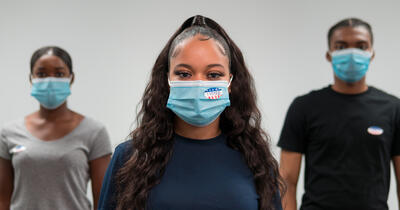
Opening the Door for Youth Voters
Young people are finding more inspiration than ever to vote and participate in the political process. President Biden’s Executive Order on Promoting Access to Voting offers significant opportunities to make voter registration easier for youth voters.

Seeing the opportunities to build a world free from the threats of climate change, racial injustice, and more, young people are finding more inspiration than ever to vote and participate in the political process—with many recognizing it as a necessity. CIRCLE found 80 percent of young people aged 18-29 believe “people like them” should participate in the political process and have the responsibility to do so. In the 2020 election, just over 50 percent of young people voted—11 points higher than in 2016, and one of the highest rates of youth voting since the voting age was lowered to 18.
These numbers are promising for the future of youth voting. However, the youth vote still lags behind overall turnout rates, election after election. In addition, only 60 percent of eligible voters aged 18-24 are registered to vote—about 12 points lower than the average for voters across all ages.
Like so many others, youth voters are held back from exercising our full political power by obstacles to voting erected by those opposed to a multiracial, inclusive democracy.
The reason for this discrepancy? Like so many others, youth voters are held back from exercising our full political power by obstacles to voting erected by those opposed to a multiracial, inclusive democracy. The factors that affect voting in America, like race, educational attainment, and income level, are compounded for youth voters like me. Many of us are still learning how to navigate the arcane voting and registration systems, made even more complex by explicit voter suppression efforts. Furthermore, we are more likely to move often, making it difficult to re-register to vote and re-learn the different rules associated with different municipalities, and are less likely to be in high-paying jobs that offer paid time off, or be able to take time off from school or work to register or vote.
As a young voter myself, I’m very familiar with these difficulties. While I consider myself a highly engaged citizen, I’ve missed out on voting due to the obstacles presented by our voting system, like missing the registration date or not knowing my polling station. I was even once sent away from my polling location because I was registered at my old dormitory instead of my new apartment down the street. As a new voter, I hadn’t realized I had to update my registration each time I moved.
My own immigrant parents were and remain ineligible to vote. Though they encouraged me to be civically engaged, they couldn’t help me navigate America’s voting system. Like so many in my generation, I was left to decipher increasingly complicated and often cumbersome registration and voting processes by myself—in part driven by elected officials nationwide who were doing everything they could to make it harder to vote.
After the Supreme Court gutted the Voting Rights Act in 2013, state legislatures across the country have moved to make it even more difficult for young people, people of color, and low-income people to vote. This only intensified after the 2020 election, when over 400 voter suppression laws were introduced across the country. As the most racially diverse generation, youth voters’ barriers to voting cannot be divorced from the barriers facing Black and brown communities across the country.
As anti-voter efforts sweep the states, the federal government has a responsibility to act to protect our democracy—including by removing barriers to registering to vote.
As anti-voter efforts sweep the states, the federal government has a responsibility to act to protect our democracy—including by removing barriers to registering to vote. President Biden’s Executive Order on Promoting Access to Voting offers significant opportunities to make voter registration easier for youth voters by directing federal agencies to consider how to incorporate voter registration and voter education activities in their everyday interactions with eligible voters. In one example, two tribal colleges, Southwestern Indian Polytechnic Institute in New Mexico and Haskell Indian Nations University in Kansas, in cooperation with the Department of the Interior, successfully secured designation as voter registration sites. These designations will result in thousands more Native youth receiving voter registration information and should serve as models for other tribal colleges and public universities and colleges.
Other agencies must also follow through on their commitments to expand voter registration services. The Department of Health and Human Services committed to integrate voter registration materials to enrollment at healthcare.gov, and Indian Health Services committed to offer voter registration assistance to the nearly 2.2 million people who utilize IHS services annually. In addition, while U.S. Citizenship and Immigration Services already offers voter registration at citizen naturalization ceremonies, they should update their policy manual to modernize and improve those services.
While these commitments are good first steps, in order to ensure that young voters can participate as soon as they are eligible, time is of the essence. All 3 agencies serve significant populations of young people and could add thousands of eligible youth voters to the rolls through strong, speedy implementation. About 3.7 million healthcare.gov enrollees and about 425,000 Indian Health Service patients are 18-34 years old. In 2020, around 625,000 new citizens naturalized, of which nearly 112,000 were under 30.
Still other federal agencies have yet even to commit to the highest-impact things they can do to implement this EO.
Still other federal agencies have yet even to commit to the highest-impact things they can do to implement this EO. The most notable oversight when it comes to reaching eligible youth voters, especially youth voters of color, is the lack of commitment to add voter registration opportunities to the Department of Education’s Free Application for Federal Student Aid (FAFSA) Student Aid Request (SAR) form. In 2019-2020, 17.7 million students filed with FAFSA, approximately two-thirds of all undergraduate students that year. It is estimated that 83 percent of Black students, 74 percent of Hispanic students, 54 percent of Asian students, and 77 percent of Native American students complete the FAFSA, in addition to 73 percent of low-income students.
By adding voter registration opportunities through the SAR, the Department of Education could reach millions of eligible but unregistered youth voters. Furthermore, students submit aid requests to FAFSA annually, which means already registered voters would also benefit as they could receive information on updating their registration each year. The Department of Education is making improvements to the FAFSA and SAR forms right now, making this the ideal time to integrate voter registration information. The Department must act quickly to take advantage of that opportunity and to fully meet the call of this EO.
Young people are ready to fight for our future, but for many, voting remains a tool out of reach.
Young people are ready to fight for our future, but for many, voting remains a tool out of reach. We need our elected officials to fight for our future, too, by leveraging the full force of the federal government to strengthen our democracy. By strongly implementing this Executive Order, the Biden administration and federal departments and agencies like HHS, IHS, USCIS, and ED can create meaningful voter registration opportunities for the young people they serve. The time to act is now—young people know better than anyone that there's no time to waste.
